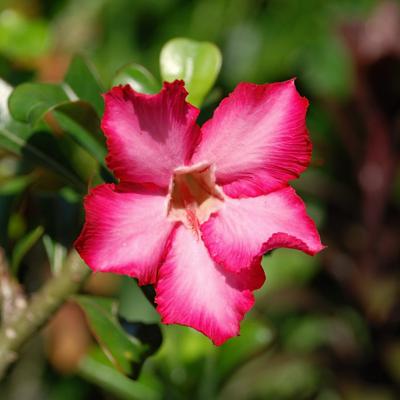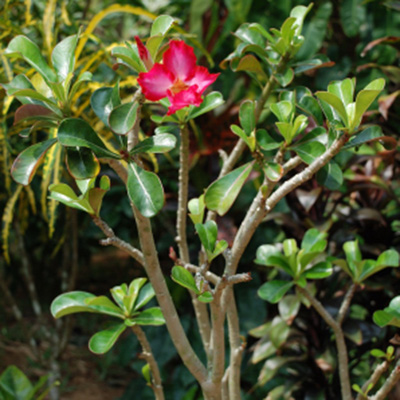Apocynaceae-Adenium-obesum
Classification
- Botanical Family : Apocynaceae
- Genus : Adenium
- Epithet : obesum
- German Family Name: Hundsgiftgewächse
- English Name: Desert Rose, Impala Lily Desert Rose, Impala Lily
- Thai Name: ชวนชม
- Thai Phonetic:
- Author: Roem. & Schult.
- Height: 1.50
Water Requirements
Plant Type
Light Requirements
Cultivation
The plant is about 1 m to 1.50 m high.
Adenium obesum is mainly cultivated as a potted plant. Thrives in a sunny site in the yard, that can dry out as well. Looks also pretty in rock gardens. Can also be grown as bonsai.
The milky sap of the plant is highly poisonous.
Propagation: is carried out both by cutting propagation and sowing. But no nice Caudex form from cuttings (= significantly thickened trunk base), which constitutes a large part of the charm of Adenium.
There are plenty of hybrids. The numerous hybrids are propagated mainly by grafting onto seedling rootstock.
Adenium obesum - obesum = dick, stämmig, fleischig, damit ist die Stammbasis gemeint.
Adenium obesum ist eine immergrüne sukkulente Pflanze, das heißt sie speichert Wasser und kann so Trockenperioden mühelos überstehen. Bei Adenium obesum dient sowohl die Stammbasis als auch der Übergangsbereich zu den Wurzeln als Wasserspeicher, die beide deutlich verdickt sind und als dekorativ angesehen werden.
Die Pflanze wird ca. 1 m bis 1,50 m hoch.
Adenium obesum wird vorwiegend als Topfpflanze gehalten. Gedeiht aber auch an einem sonnigen Standort im Garten, der gut abtrocknen kann. Sieht besonders hübsch in Steingärten aus. Kann auch als Bonsai kultiviert werden.
Der Milchsaft der Pflanze ist stark giftig.
Die Blütenfarbe reicht von weiß über rosa bis zu rot und violett. Blüht das ganze Jahr über.
Vermehrung: erfolgt sowohl durch Stecklingsvermehrung als auch durch Aussaat. Stecklinge bilden jedoch keinen hübschen Caudex (=deutlich verdickte Stammbasis) aus, der einen Großteil des Charmes von Adenium obesum ausmacht.
Es gibt eine Vielzahl von Hybriden. Sie sind vor allem vermehrt durch Pfropfen von Stecklingen auf einen Wurzelstock.
Origin
Miscelaneous
Further uses: The highly toxic milky sap of the plant used in Africa as an arrow poison.
Weitere Verwendung: Der stark giftige Milchsaft der Pflanze wird in Afrika als Pfeilgift verwendet.


